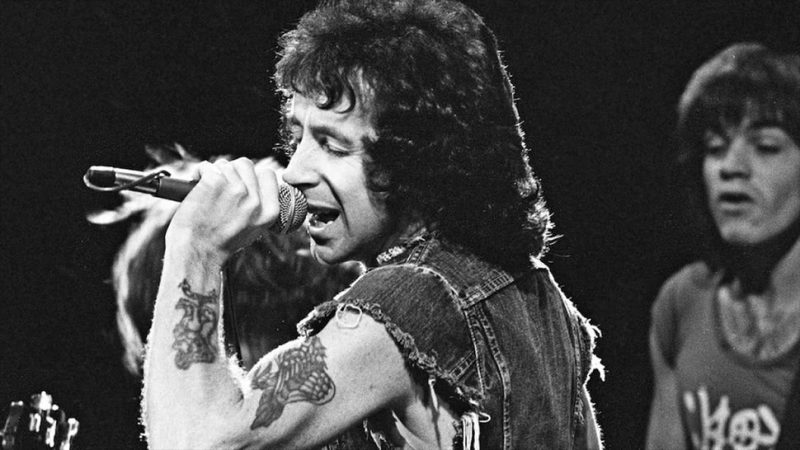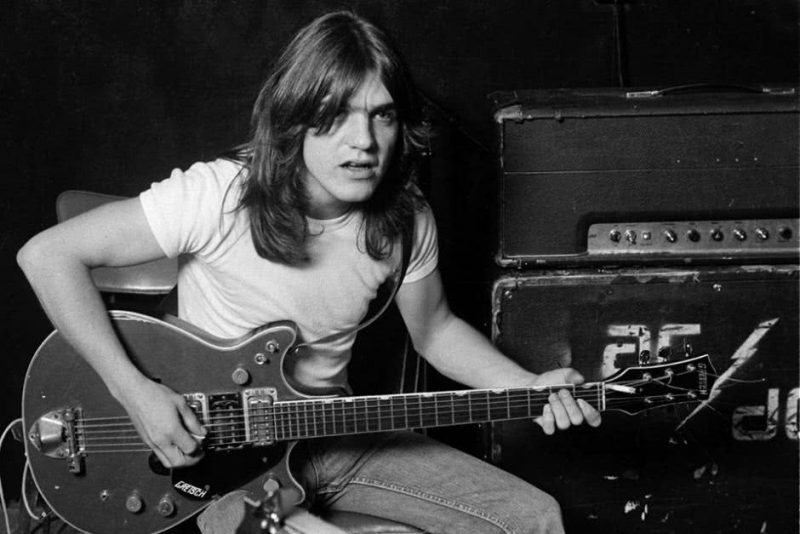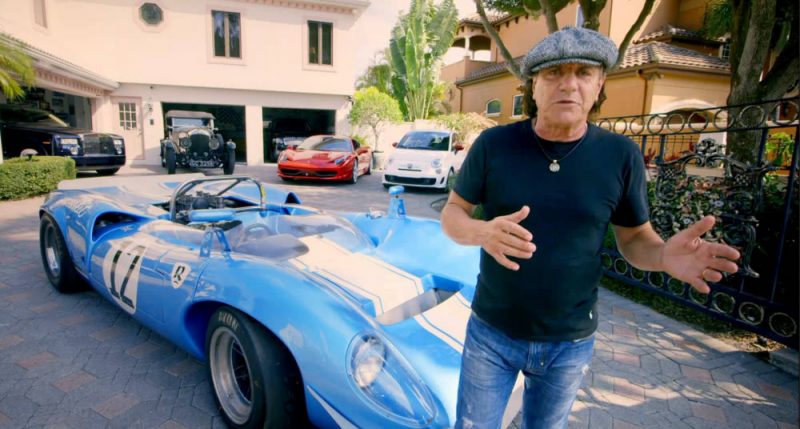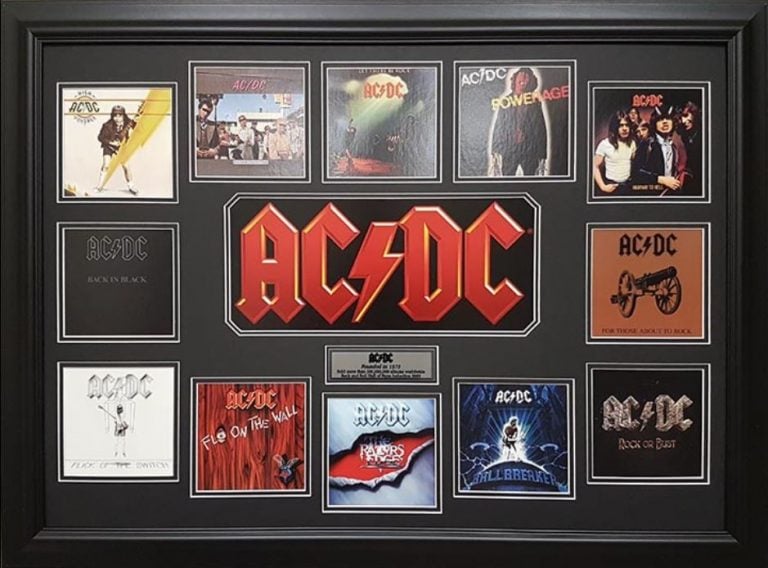At an early AC/DC show in Sydney, an exuberant Bon Scott fell off the stage. It was too high to jump back on, so he raced around to the backstage door to get back on.
“Where the *** are you *** going ***?” said a security guy.
“I’m in the **** band, ****!”
“Bullshit ***, get back into the *** crowd.”
There lay AC/DC’s enduring appeal which helped them sell 140 million copies.
They looked like their audience, dressed like them, lived like them and played the dirt-around- the-collar music they liked. Malcolm was the Human Riff and Angus would say his brother’s guitar was strung with barbed wire.
“With AC/DC, we’ve always started with rock, and we’ve just kept it going. The critic’s view is always, ‘They just made an album and it’s the same as the last one,'” Angus shrugged to Guitar World in 1991. “I’ll have 15 of them, anytime.”
Love Music?
Get your daily dose of metal, rock, indie, pop, and everything else in between.
But on their highway to sell, the records were affected by exhaustion, feuds, alcoholism and drugs, hearing loss and wrong producers.

(20) Fly On The Wall (1985)
When AC/DC lumbered up to Mountain Studios in Montreux, Switzerland to cut their 10th studio album, posturing glam metal hair was at its peak, and Angus and Malcolm wanted to make a record that was as gritty and real as their early ones made in Australia to counterattack.
Noble sentiments, but alas, someone forgot to pack the tunes.
Only ‘Shake Your Foundations’ and ‘Sink The Pink’ survived. Even the album cover art sucked.
Australia: #4, certified platinum 3
US: #32, one platinum
UK: #7, silver
(19) Blow Up Your Video (1988)
Indications were magic would flow at sessions in the south of France for their 12th album, especially as first producers Harry Vanda and George Young were back on the boat.
Alas, as George would admit to Rolling Stone in 2008, that was when he realised that Malcolm had become an alcoholic.
“I saw the signs. Malcolm had a problem. I said if he didn’t get his act together, I was out of there. I don’t recall it (his threat) having any effect.”
Only ‘Heatseeker’ and ‘That’s The Way I Wanna Rock’n’Roll’ had a meaningful presence.
Australia: #2, platinum 3
US: #12, platinum
UK: #2, gold

(18) High Voltage (1975)
This was their Australian debut. The international version from 1976 was a mixture of the Australian versions of High Voltage and the follow-up T.N.T.
At this stage, they were still working out their sound. But as George Young said, “It was obvious they had it.”
This was recorded in between gigs, and the songs were what worked in concert, including Big Joe Turner’s ‘Baby Please Don’t Go” and their own ‘She’s Got Balls’ and ‘Soul Stripper’.
Australia: #14, platinum x 5
US: #146, platinum x 3
UK: gold
(17) Flick Of The Switch (1983)
Their 8th album was cut in Compass Point Studios in Nassau, in the Bahamas where AC/DC created Back In Black with producer Robert John “Mutt” Lange.
This time there was no Lange, and no decent songs. Not only was Malcolm proving to be a problem but drummer Phil Rudd was fired during sessions. They were exhausted and tense, and the flat reheated riffs showed.
Australia: #3, platinum 3
US: #15, platinum
UK: #4, silver
(16) Live at River Plate (2012)
“My rule is that if you’re not sweating when you come offstage, something’s wrong,” Brian Johnson would say.
That was the case when AC/DC returned to Argentina in December 2009 after 13 years, playing three nights in a Buenos Aires soccer stadium to 200,000 as part of the Black Ice tour.
It was the companion to the DVD / Blu-ray which, it had to be said, was far superior in capturing the band and crowd’s excitement.
Australia: #11, gold
US: #66
UK: #14

(15) Ballbreaker (1995)
The good news was that arch AC/DC fan Rick Rubin took on producer duties, and Phil Rudd was back after catching up them during their NZ tour and pitching for his old job.
The bad news was that they had ‘sound’ problems, and switched studios after which they dumped many tracks.
Rubin got a great tough and warm sound. But he and Malcolm clashed over the record’s direction and his approach of doing multiple takes (up to 50 once).
Sessions ran over, and Rubin had to juggle sessions with Ballbreaker and the Red Hot Chilli Peppers’ One Hot Minute.
An absent producer towards the end and a stack of cringeworthy schoolboy sex lyrics and mostly forgettable riffs except for ‘Hard As A Rock’ couldn’t save the good bits.
Australia: #1, platinum x 3
US: #4, platinum 2
UK: #6, gold
(14) Rock Or Bust (2014)
The Seedies had their share of dramas, of course but if there was ever a time to throw in the towel, it was just before Rock Or Bust.
On their last Australian tour, rumours were circulating backstage about Malcolm’s dementia. It became official in 2014 and he left just before sessions began.
His unused riffs from earlier albums were utilised for Rock Or Bust, re-recorded by nephew Stevie.
Then there was Phil Rudd’s legal chaos in New Zealand, including marijuana possession on his boat and a trumped-up charge of trying to get two men killed although that was later dropped.
Rock Or Bust, made in Canada in four weeks with producer Brendan O’Brien and mixer Mike Fraser, ran at just a mere 35 minutes.
It had a couple of stand-outs like the title track, ‘Play Ball’ and ‘Rock The Blues Away’ but hardly essential and sales were down. Nevertheless it went to #1 in 12 territories.
Australia: #1, platinum
US: #3, gold
UK: #3, gold
(13) For Those About To Rock (1981)
After the major comeback with Back In Black, the Seedies headed off to Paris to work on a follow up to deliver a second punch.
The title track was magnificent: ominous, epic and one of rock’s well delivered anthems.
It was inspired by the ancient Roman gladiators’ declaration “Ave, Caesar, morituri te salutant” (“Hail Caesar, those who are about to die salute you”) but directly from a line Angus remembered from a book by English poet and historian Robert Graves after his visit to the Colosseum in Rome where the gladiatorial battles took place.
They were recording the track when someone in another room was watching the Charles and Diana wedding on TV and cannons went off…
However the rest of the album hardly matched up. During sessions, they were clashing with perfectionist Lange, in the way they had to sit for hours while he did take after take. They never worked with him again.
Malcolm said: “By the time we’d completed the album, I don’t think anyone, neither the band nor the producer, could tell whether it sounded right or wrong. Everyone was fed up with the whole album.”
Not helped by a lacklustre lead off single in ‘Let’s Get It Up’, the album just limped to 4 million sales in the US and 7 million worldwide compared to Back In Black’s 25 million in the US and 50 million globally.
Australia: #3, platinum x 5
US: #1, platinum x 4
UK: gold

(12) T.N.T. (1975)
Hot on the heels of their debut album High Voltage, T.N.T. was recorded just months after, and quickly established the AC/DC sound.
It had some of their long surviving live staples – ‘It’s a Long Way to the Top’ (If You Wanna Rock’n’Roll), ‘The Jack’ (a girl in Melbourne wrote to Malcolm accusing him of giving her VD). ‘Rock And Roll Song’, ‘Live Wire’ and ‘Rocker’.
There were happy accidents. At the end of ‘It’s A Long Way’ after Bon claimed he’d been in a pipe band, George suggested he added bagpipes on it. It was only later that he learned that, yes, Bon had been in a pipe band but played drums.
The “oi! oi!” chant on ‘T.N.T.’ came when George heard Angus goofing about during an early playback and suggested it stay in.
‘High Voltage’ saw Angus deliberately playing with the chords A…C…D…C to see what came.
‘Rocker’ stopped abruptly because the tape ran out unexpectedly.
AC/DC were certainly not making up the rough image. The Melbourne launch party of T.N.T. coincided with the day that Juke magazine’s review came out, criticising the record’s thin production which clouded some of Angus’ solos.
At the party, band members rushed around the guests demanding to know if they’d written it. The reviewer wasn’t at the party, so they punched out a Juke staffer who ironically had been an early AC/DC champion!
That criticism of T.N.T. would also be taken up by international critics when T.N.T. tracks were released globally in 1976 mixed with High Voltage under the latter’s name.
Australia: #2
(11) Live (1992)
AC/DC’s second live album was recorded over several dates on 1991’s The Razor’s Edge tour in Europe and Canada. It was released in a single and double CD format and the Live at Donington DVD.
This is a great live album, with all their hits delivered in high octane, and the double album featuring a 14-minute ‘Jailbreak’.
Australia: #1, platinum x8
US: #15, platinum x 3
UK: #5, gold
(10) Let There Be Rock (1977)
Their fourth album (and their final with bassist Mark Evans), Angus describes this as “the one that defined us.”
Before sessions began, producer George Young asked his brothers, “What would you like to do with this album? How do you want it to come out?”
Malcolm replied, “We want an album that’s full-on guitar and in-your-face and pure hard rock.”
It was always meant to be a big ‘fuck you’ to US label Atlantic for threatening to drop them.
Let There Be Rock was that, mostly recorded live in the studio with occasional out-of-tune guitars kept in for its spirit) with thunderstorm attacks as the title track (beautifully capturing listening to rock as a religious experience), ‘Whole Lotta Rosie’ (a 19-stone lady from Tasmania who told Bon he was her 37th for the month), ‘Hell Ain’t A Bad Place To Be’ and ‘Dog Eat Dog’.
The fingers on the Australian LP cover are Sydney axeman Chris Turner’s, as the Youngs were out of town.
Australia: #19, platinum x 5
US: #154, platinum x 2
UK: #17, gold
(9) The Razor’s Edge (1990)
After a stale patch in the late ‘80s, AC/DC stormed back into the new decade with one of their classics.
There were some distractions in the beginning. Drummer Simon Wright left to rejoin Dio and was replaced by Chris Slade. Brian was in the midst of a divorce and couldn’t contribute lyrics.
Sessions began at Windmill Lane Studios in Dublin with George Young.
But he soon had to bow out due to “personal problems”. The Youngs’ father William died in 1985, followed by mother Margaret three years later, and Young’s mentor, label executive and record producer Ted Albert in November 1990.
Bruce Fairbairn, a fellow Scotsman from Canada, was suggested, and their humour and recording style (he worked with Bon Jovi, INXS and KISS) clicked.
Sessions moved to Canada. Fairbairn took Angus aside and told him, “I want you to sound like AC/DC when you were seventeen.”
It worked. ‘Thunderstruck’ was a magnificent opener, full of riffs and the pub-rock chant of the song’s title repeated 39 times.
Angus: “It started off from a little trick I had on guitar. I played it to Mal and he said ‘Oh, I’ve got a good rhythm idea that will sit well in the back.’
“We built the song up from that. We fiddled about with it for a few months before everything fell into place.”
The other tracks were completely finished songs, as opposed to the insistent barbed wire riffs, which got them back on radio with ‘Fire Your Guns’ and ‘Moneytalks’.
But at the other end of the scale were forgettable stinkers as ‘Mistress For Christmas’ (about Donald Trump’s extra marital flings), ‘Goodbye & Good Riddance’ and ‘Rock Your Heart Out.’
Australia: #3, platinum x 5
US: #2, platinum x 5
UK: #15, gold
(8) Black Ice (2008)
Coming after an eight year gap from 2000’s Stiff Upper Lip, the Youngs had a lot of time to work on ideas for Black Ice, their 15th album.
“I know that the boys wanted something special,” Brian Johnson told Classic Rock. “They really, really did.
“And when Angus and Malcolm make their mind up on something, they are stubborn. They will not stop until they get what they want. They’re two stubborn guys when it comes to perfection.”
According to Malcolm, “about 60 or 70 song ideas” were developed. The idea was to record 18 and choose eleven.
But band members had their favourites and the final cut was 15 songs and the longest running time of any AC/DC studio album at over 55 minutes.
In a way, the decision worked against its ranking. Black Ice had some of the best tracks since Back In Black, including ‘Rock ’N’ Roll Train’, ‘Big Jack’, ‘Black Ice’, ‘Decibel’ and ‘Anything Goes’.
The band pumped on all eight cylinders, especially Malcolm, and producer Brendan O’Brien’s utter love for early AC/DC records gave it an exhilarating sense of purpose.
However, there were too many samey tunes that sharper culling would have given Black Ice a greater all-round purpose. At least they didn’t plump for a double album.
Regardless, it was their artistic and commercial comeback, hitting #1 in 29 countries and shifting 6 million copies in the first two months. A great effort since they were one of the last major bands to hold out from doing deals with YouTube or tap into the streaming phenomenon.
Australia: #1, five x platinum
US: #1, double platinum
UK: #1, platinum
(7) Stiff Upper Lip (2000)
Everything fell into place on this one, their 14th album. Malcolm and Angus spent nine months in London and Amsterdam getting 18 songs done and dusted.
These included ‘House Of Jazz’, the thunderous ‘Safe In New York City’ and gritty ‘Satellite Blues’.
Then they moved to Vancouver, Canada, to Bryan Adams’ Warehouse Studios.
Cliff Williams told VH1’s Behind the Music: “It’s a killer album. It was a very easy-to-record album in as much as Malcolm and Angus had everything ready to go, so we basically just had to come along and perform as best we could.”
The plan had been to use Bruce Fairbairn again. But he died in May 1999, and the role fell to brother George Young and Mike Fraser, who co-produced 1995’s Ballbreaker with Rick Rubin.
The older Young’s skilled strategy in the studio grabbed the punch and authenticity of the AC/DC sound, as the crew put in 14 hour sessions.
It would be the last AC/DC album that George would work with them on. He died in 2017.
Australia: #3, platinum
US: #7, platinum
UK: #12, gold

(6) Powerage (1978)
The Rolling Stones’ Keith Richards, Van Halen’s Eddie Van Halen and Aerosmith’s Joe Perry regard Powerage as their favourite AC/DC album.
“The whole band means it, and you can hear it,” Richards said.
Malcolm regarded it – their fifth studio album – as their most under-rated record.
Powerage introduced fans to English bassist Cliff Williams after Mark Evans was sent home to Sydney following clashes with Angus.
It had their most consistent collection of songs, Williams described working with Vanda and Young and their live-in-the-studio approach as a “real fiery, energetic work environment”, and some of the lyrics saw Bon Scott hailed as a street poet in some quarters.
The songs included ‘Sin City’ about Las Vegas, ‘Kicked In The Teeth’, ‘What’s Next To The Moon’, ‘Down Payment Blues’, ‘Riff Raff’, ‘Kicked In The Teeth’ and ‘Up To My Neck In You’.
When their US label Atlantic couldn’t see a radio, they hastily came up with ‘Rock ‘n’ Roll Damnation’ which became their best selling single in Britain at the time.
It was early days for AC/DC in America. It only reached #133 there, but eventually sold a million.
Atlantic was determined that for their next album they would not use the Vanda-Young production team but someone international who would drive the band towards a more radio-friendly sound.
Australia: #22, platinum x 3
US: #133, platinum
UK: #23, gold
(5) If You Want Blood (1978)
AC/DC’s first live album was recorded at Apollo Theatre in Glasgow, Scotland, which Angus remembered was “the magic show” of the Powerage tour of 1978, made so when the band came on stage wearing Scotland football shirts.
The record couldn’t miss, with the setlist from all the gems from T. N.T., Dirty Deeds Done Dirt Cheap, Let There Be Rock (a 8½ minute encore of the title track) and Powerage.
The title came from a journalist asking what the audience could expect from an AC/DC show and Bon replied, ”Blood!” The art cover featuring Angus impaled on his guitar drove the message home.
Malcolm on why the record is ranked as one of the best live albums of all time: “We were young, fresh, vital and kicking ass.”
Australia: platinum x 3
US: platinum
UK: gold
(4) Power Up (2020)
Angus watched the calm and practical way Malcolm approached the dementia which killed him in 2017, and applied that to the disasters befalling various band members in the run up to sessions for Power Up.
Brian, Cliff and Phil returned after their respective bad mugambows.
This was as close to the classic lineup as possible, but their 17th album still featured Malcolm as a main songwriter.
Angus: “A lot of the ideas come from around the time just before Black Ice.
“When we made that album, we had so much material because we’d had a lot of years off and the two of us had written so many songs.
“So I just thought, ‘I’ll concentrate on the ones I knew that he really loved so much and get them out. That was the guide I used.”
Every track was a killer, with the torn and frayed ‘Shot In The Dark’, ‘No Man’s Land’ and ‘Witch’s Spell’ continually hitting the mark, the lyrics ranging from humour to wistfulness (‘Through The Mists Of Time’).
It went to #1 in 21 countries, and they became the first act to have an Aussie #1 album in each of the five decades (1980s to 2020s).
Australia: #1, gold
US: #1, platinum x 7
UK: #1, gold
(3) Dirty Deeds Done Dirt Cheap (1976)
The record was vaguely based on a Humphrey Bogart mystery movie – and was so deliciously dangerous and crass that their US label Atlantic initially refused to release it in America even though it paid $25,000 for it.
Other versions of this story were that they didn’t like Bon’s voice and wanted him sacked, or they hated the record so much there were dark rumblings about dropping AC/DC.
For Australians, it contained some of their longest surviving tracks from the Bon era.
The title track was inspired by TV cartoon Beany and Cecil, a fave of Angus’ as a kid where the character Dishonest John carried a business card that read “Dirty deeds done dirt cheap”.
Others included ‘Jailbreak’, ‘Ride On’, ‘Problem Child’, ‘Squealer’ (about the time Bon screwed a virgin), ‘Ain’t No Fun (Waiting ‘Round To Be A Millionaire)’, ‘Big Balls’ and ‘RIP’.
Australia: #3, platinum x 6
US: #3, platinum x 6
UK: silver
(2) Back In Black (1980)
Back In Black is the album most global fans regard as their favourite. It was their farewell to Bon and the introduction of Brian Johnson. Mutt Lange’s thunderous yet commercial production gave hard rock in general a good fist up the ass when the style was floundering.
It shifted 50 million units, the second biggest seller of all time after Michael Jackson’s Thriller.
It had tremendous hits including the title track, ‘You Shook Me All Night Long’, ‘Hells Bells’ and ‘Rock and Roll Ain’t Noise Pollution’.
It was made over seven weeks in Nassau in the Bahamas.
But the experience not as romantic as you’d think. A series of hurricanes (cited in the lyrics to ‘Hells Bells’) played havoc with the studio’s electricity supply and at night they had to sleep with shark guns to repel thugs moving about looking for rich westerners to rob.
For ‘Hells Bells’ the band got a foundry to make the bell but it was going to take seven weeks. Plan B was to record local church bells, but that ran into problems with birds fluttering every time the bells clanged, so AC/DC were forced to return to Plan A.
Australia: #1, platinum x 12
US: #4, platinum x 25
UK: #1, platinum x 2
(1) Highway To Hell (1979)
AC/DC sixth Australian studio album was where all the elements fell together.
Relentless worldwide touring had honed them into an eight cylinder machine, and new producer ‘Mutt’ Lange who put them through gruelling 15-hour sessions which gave their sound a polish and radio friendliness which broke them into the international arena.
Lange was a good musician and a trained singer, and won their respect on how to push up the bar even if the band didn’t like being told what to do.
When Bon was doing the vocals for ‘If You Want Blood’, Lange pointed out there was more breathing than singing coming out of him.
Scott’s response: “You’re so fucking good, cunt, you do it!”
Lange, still seated in the producer’s chair, delivered exactly what was needed.
Later he showed a sceptical Angus how to frame the solo on ‘Highway To Hell’.
This triggered a new-found respect for him.
The song ‘Highway To Hell’ started in a Miami recording studio. Their US label wanted them to do a cover of a British ‘60s band Spencer Davis Group hit, which they were furious about.
Angus told Malcolm “I think I’ve got a good intro here.” Malcolm slipped behind the drum kit and gave him the beat.
As for the title, Angus says it was a reply to an American journalist who asked him what touring was like, “Oh, it’s a highway to hell! When you’re sleeping with the singer’s socks two inches from your nose, that’s pretty close to hell.”
However it is more likely after WA’s Canning Highway, which had that nickname due to its many fatalities, and on which Bon wrote on to catch up with his drinking mates.
Other standouts were ‘Shot Down in Flames’, ‘Touch Too Much’, ‘Beating Around the Bush’, ‘Girls Got Rhythm’ and ‘Walk All Over You’.
Australia: #13, platinum x 5
US: #17, platinum x 7
UK: #8, platinum
For more on this topic, head over to the Classic Rock Observer.

































